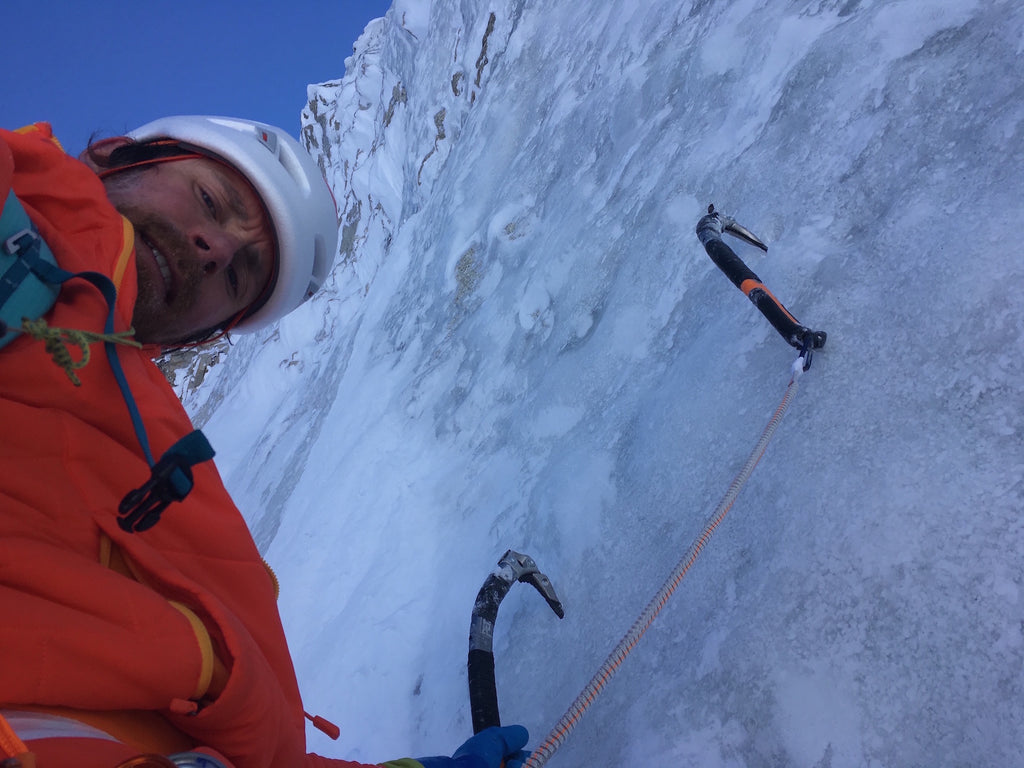Disclaimer: Climbing is inherently dangerous. The descriptions of techniques and procedures in this article are intended to provide general information. This is not a substitute for formal instruction, routine practice, and plenty of experience. When you follow any of the procedures described here, you assume responsibility for your own safety. The information below is a "personal opinion piece" and has been provided in good faith. It cannot be seen as "complete" as it does not cover every eventuality. We are simply offering readers useful information for such a complex sport. Hope you enjoy reading through this article!
The Freedom of Being Lighter
Fast and Light Petzl Athlete Colin Haley beautifully argues the freedom of being lighter.
“Moving faster in the mountains means spending less time exposed to the risks of being in the mountains, but it also means having a smaller margin of safety should something go wrong.”
This makes total sense, but that is not the end of the story. Most recreational climbers are not linking up the Patagonian skyline or attempting a sub 2 hour Nose ascent. They go out just to have fun and adventures with friends, so why go lighter?
Three More Reasons to Buy Light
1. More Fun, Less Work
Carrying a heavy pack sucks! The data shows heavy ski touring bindings require you to have a better VO2 output to keep up with your lightweight buddies ahead; the same can be said for climbing gear. Getting into amazing shape by doing conditioning drills is awe inspiring! Or, you can have a regular job, drink a few beers, buy gear that weighs 50% less and still be fit enough to get out there. The boom in mountain activities is partly due to the suffering being lessened. Doing an afternoon run up the Chief requires some fitness, but it certainly pales in comparison to hauling heavy 100lb packs on hemp ropes. The fun factor is higher than ever before. Climbing with lighter gear feels better, more pitches can be climbed in a day, higher grades can be attained and you get home with some pull left in your arms. Doesn't that sound like more fun? In general, it seems that lighter gear means that more people can try more things and have more fun.
2. More Stuff and More Safety Margin
My pack size has not reduced with smaller lighter gear. Why? Because having lighter gear means you can take a communication device, that extra layer, a camera to capture the day, a first aid kit and a tarp. So the fast and light trend actually increases the safety margin because you can now realistically carry the safety tools recommended without feeling like a pack mule. You also have the option of pretending to be a cutting edge alpinist!
3. Busy Lives and Limited Time
Your report needs completing and your shift starts at 3pm but your colleagues work in a different time zone. Each of us live very busy lives, but that little buzz in your brain craves a quick mountain fix and windows of opportunity pop up all the time. If only that 5 hour climbing objective was just 2 hours, so that you could squeeze in a lap before work! Fast and light gear is freeing people to get their mountain fix before picking up the kids at school or after their work meetings are done. This isn't cutting edge alpinism; this is you and I improving our lives and feeling satisfied.
5 Tips For Moving Quickly In Alpine Terrain
1. Efficient Transitions
Building anchors efficiently combined with swinging past to lead the next pitch can save hours. Practice smooth transitions with clean efficient anchor systems that you and partners are familiar with. The second should arrive at the anchor with gear racked neatly ready to swing into the role of lead and the belayer at the anchor should be organized to facilitate a fast pass off. When switching between rock and snow be familiar with your crampons, have them readily accessible, and transition before you are scared to change. Dial in your systems from ascending to descending, flaking a rope, and setting up rappels.
2. Know Your Route
Getting lost will cost you hours and possibly daylight, but being very familiar with your route will save you hours too. Do your research, plot your GPS track, fly the route in google maps, study pictures, seek local knowledge, read the guide book, and ask people who have completed the route. A combination of insider knowledge and general route finding, combined with skills to deal with terrain quickly will often reduce a full day route by hours.
3. Stay Fed and Hydrated
By the time your tongue is dry and your stomach craves food, you have already started to reduce your athletic ability and decision making. Drink on the go using a water bladder and munch on bars on the move. Keep your food tasty and interesting because you are much more likely to eat it; add a hydration mix to your water, it will taste better and will provide instant sugar.
4. Predict the terrain
As you are walking along enjoying the views, take a moment to think about that bergschrund coming up. Having a plan and possible solutions for upcoming mountain terrain will remove the stops and discussions. Knowing if you can rappel a pitch with one rope or require a second rappel will save time. Using the terrain to protect the team, slinging blocks, switching sides of the ridge, and using natural features can keep things moving along.
5. Early Starts and Headlamps
The early hours, before the sun rises, are often the coolest. Cool, morning hours firms up the snow, reduces rock fall, strengthens snow bridges and reduces avalanches. Take advantage of the better temps and fly past problems that might be dangerous later in the day.
Fast and Light Philosophy
One company that stands out from the rest when it comes to Fast and Light equipment is Petzl. They continue to examine and re-examine gear to save grams for Alpinists. This can be seen across their products from ropes and slings to complete systems like their RAD (Rescue and Descent) crevasse kit. They have adopted a fast and light (FL) approach to skiing equipment, mountaineering tools and climbing gear, which has opened up possibilities for a few hardcore devotees and lightened the load for the rest of us.
Petzl's team of athletes have been using the FL gear to achieve notable ascents over the past few years. We love their gear improvements and the progression in alpinism that lightweight equipment allows. Some of the most notable ascents completed are achieved with the same Petzl gear available to you. Your pack can weigh the same as theirs; maybe owning these items will spark a flame in you to just go try!
Colin Haley completed a 17 hour and 13 minute round trip of Begguya (Mt. Hunter aka "Denali's Child"). Mount Hunter is the third highest major peak in the Alaska Range and Haley credits a combination of improved fitness, tactics, light equipment and familiarity with the route for his success. He encountered difficulties up to M4/5 and completed the technical difficulties in 5 hours and 18 minutes. This fast and light style was made possible by rope soloing sections with an 80m 6mm rope and reducing his pack weight wherever he could.

Solo Athlete: Colin Haley | Photo Credit: Colin Haley
Colin Haley's favourite helmet is the Petzl Sirocco Ultralight Helmet - 160g. The Sirocco has been Haley's favourite helmet for a few years, because "it is incredibly lightweight and, unlike other super light helmets, doesn't disintegrate in your checked airline baggage!"
On this ascent, Haley also took the following FL items:
- Petzl Laser Speed Light Ice Screws = 100g - As suggested by the name, these screws are ultra-lightweight featuring an aluminium tube that gives you a far lighter kit than their heavier steel tubed counterpart.
- Petzl Quark Ice Tools = 465g each - These ice tools are an excellent all-arounder for mountaineering and ice applications.
- Petzl Rad Line = 22g/m. Petzl's ultralight, hyperstatic, and compact cord ideal for glacier travel, crevasse rescue, and rappels.
- Petzl Pur'anneau Slings = 18g/60cm - A very lightweight sling with exceptional durability and absorbs almost no water.
It is important to remember that...
Going faster isn't 100% about the weight of the gear. It is a combination of athletic ability, training, tactics, risk tolerance, conditions and strategy. Doubling Colin's pack weight would slow him down, but he would still be faster than most alpinists out there.
Fast and Light Objectives in the Sea to Sky Corridor
While most of us don't have the fitness, skills and time to fly to Alaska for a quick ascent of Mt. Hunter, we can find amazing local objectives that can be completed in a day especially with the right lightweight gear. Here are some objectives in the Sea to Sky Corridor.
Sky Pilot
Head up the Sea to Sky Gondola, jog along the logging road and up towards Stadium glacier. Do one quick pitch and you'll hit the summit before noon! You can be back for a latte and go straight into a zoom meeting. All smiles!
Tricouni
Early morning drive up the logging road, one hour of mellow snow up to the col, a quick rope up to cross the glacier and access the ridge, summit, down climb, rap and late lunch at The Locavore. Satisfied!
The Tantalus Traverse (our favourite)

Heli-drop by Zenith Lake, gain the ridge and traverse up over to Mt. Tantalus, drop down and around Mt. Dione. Head across and pass under Serratus, drop down to Lake Lovely Water and head for the Squamish River. Top 100 tick!
(Disclaimer: We have deliberately been vague with the route descriptions for the Tantalus Traverse. You should have intimate knowledge of the route before you attempt it "fast and light"!)
The Tantalus Traverse Kit
Being "Squamish based" means we have the Tantalus range staring at us all day long. This classic alpine traverse can be completed in a single day or over many days in many different styles. Many variations of the Tantalus traverse have been completed over the years. We recommend understanding your physical capabilities, the terrain, the weather, technical skills and risk tolerance before attempting this traverse in a fast and light style.
The skill kit for the Tantalus traverse is diverse. You need rock skills, glacier travel skills, mixed climbing skills (to navigate transitions between glaciated and rock terrain), rappel anchor building skills (if you get off route on rappels or end up doing shorter rappels than the fixed anchors because your rope gets cut), navigation skills, first aid skills and more! The following gear kit is aimed at a fit and fast party of two looking to complete the traverse in a single day.
Hardware
-
Harness
i.e. Petzl Altitude Harness -
Helmet
i.e. Petzl Sirocco Ultralight Helmet -
Headlamp
i.e. Petzl IKO Core Headlamp 500 Lumens -
Rope
i.e. Mammut 8.7mm Alpine Sender Dry Rope -
Rack
i.e. 3 x Black Diamond Camalot™ Ultralight -
Draws
i.e. 4 x Camp Mach Express Alpine Draws 4 Pack -
Carabiners
i.e. 11 x CAMP Nano 22 Carabiners -
Locking Carabiner
i.e. 1 x Grivel Plume K3G Twin Gate Carabiner -
Cordlette
i.e. 5m x 5mm Sterling Rope 5.9mm PowerCord -
Ice Axe
i.e. Petzl Gully Ice Axe -
Crampons
i.e. Petzl Leopard FL Crampons -
Belay Device
i.e. Edelrid Mago Figure 8

Women's Apparel
-
Footwear
i.e. Scarpa Women's Mescalito Mid Gore-Tex Approach Shoe -
Socks
i.e. Smartwool W's Athlete Edition Hike Crew -
Pants
i.e. Black Diamond Women's Alpine Light Softshell Pant -
Wicking Tee
i.e. Black Diamond Genesis Tech Tee or Outdoor Research Argon Tee -
Long Sleeve Lightweight Active Layer
i.e. If available MHW Airmesh Hoody -
Lightweight Puffy
i.e. Outdoor Research Helium Insulated Hoody or MHW Kor Strata Hoody -
Lightweight Rain Jacket
i.e. Outdoor Research Women's Helium Rain Jacket or MHW Exposure 2 Paclite Plus Jacket -
Gloves
i.e. Black Diamond Lightweight Softshell Glove -
Pack
i.e. Mammut Women's Trion Nordwand 28L Alpine Pack

Men's Apparel
-
Footwear
i.e. Scarpa Men's Mescalito Mid Gore-Tex Approach Shoe -
Socks
i.e. Smartwool Performance Hike Light Cushion Mountain Range Pttn Crew -
Pants
i.e. Black Diamond Men's Alpine Light Softshell Pant -
Wicking Tee
i.e. Black Diamond Genesis Tech Tee or Outdoor Research Argon Tee -
Long Sleeve Lightweight Active Layer
i.e. if available Mountain Hardwear Airmesh Hoody -
Lightweight Puffy
i.e. Outdoor Research Helium Insulated or MHW Kor Strata Hoody -
Lightweight Rain Jacket
i.e. Outdoor Research Men's Helium Rain Jacket or MHW Exposure 2 Paclite Plus Jacket -
Gloves
i.e. Black Diamond Lightweight Softshell Glove -
Pack
i.e. Mammut Men's Trion Nordwand 28L

Emergency Kit
-
Communication
i.e. Garmin InReach Mini -
First Aid
i.e. Ultralight/Watertight First Aid Kit -
Space Blanket
i.e. Survive Outdoors Longer Emergency Blanket

Personal Kit
-
Sun Protection
i.e. All Good SPF50 Sunscreen Butter 1oz. -
Eyewear
i.e. Sunglasses with Cat 4 protection. Picture photochromic Bolle or Julbo -
Knife
i.e. Nite Ize DoohicKey® Key Chain Knife -
Navigation
i.e. FatMap on your iphone 12 -
Don't forget the food!

Reasons not to go Fast and Light

-
“Stop to smell the roses”. Waking up on top of a mountain and capturing the sunrise is something everyone should experience. Spending time to soak it all in rather than rushing through can create the most amazing lasting memories.
-
Check your weather window! Being in the mountains in bad weather is, at least uncomfortable and sometimes dangerous, taking extra layers and a shelter may save your life.
-
Know your physical limitations. If the goal is to cover 30km in a day, and you almost pass out while hiking the Chief, it's best to re-align your goals with your own personal limitations.
-
Know the difficulty of the objective. Tackling the Sharks Fin on Meru? You might need a few extra things for this; it's best to include a portaledge and a few extra winter items. Match your gear to the objective!
-
Know your risk tolerance and understand the balance between likelihood of success and consequence of failure. If it's likely you won't succeed and face an open bivy with high chance of hyperthermia, take the extra gear.
-
Margin of error. Taking extra gear gives you a greater margin for error and sometimes also a greater chance of success.












Leave a comment